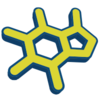ChEBI
 | |
| Content | |
|---|---|
| Description | Chemical database |
| Data types captured | Chemical Entities of Biological Interest |
| Contact | |
| Research center | European Molecular Biology Laboratory |
| Laboratory | |
| Primary citation | [1] |
| Access | |
| Website | ChEBI |
| Download URL | Downloads |
| Web service URL | Web Service |
| Sparql endpoint | BIO2RDF |
| Tools | |
| Web | ChEBI Website |
| Miscellaneous | |
| Data release frequency | monthly |
| Curation policy | Manually curated |
Chemical Entities of Biological Interest, also known as ChEBI,[1][2] is a database and ontology of molecular entities focused on 'small' chemical compounds, that is part of the Open Biomedical Ontologies effort. The term "molecular entity" refers to any "constitutionally or isotopically distinct atom, molecule, ion, ion pair, radical, radical ion, complex, conformer, etc., identifiable as a separately distinguishable entity".[3] The molecular entities in question are either products of nature or synthetic products which have potential bioactivity. Molecules directly encoded by the genome, such as nucleic acids, proteins and peptides derived from proteins by proteolytic cleavage, are not as a rule included in ChEBI.
ChEBI uses nomenclature, symbolism and terminology endorsed by the International Union of Pure and Applied Chemistry (IUPAC) and Nomenclature Committee of the International Union of Biochemistry and Molecular Biology (NC-IUBMB).
Scope and access
All data in the database is non-proprietary or is derived from a non-proprietary source. It is thus freely accessible and available to anyone. In addition, each data item is fully traceable and explicitly referenced to the original source.
The ChEBI data is available through a public web interface, Web Service and downloads.
Similarity measures
Semantic similarity measures exploring the hierarchy of ChEBI classes[4] and its disjointness axioms[5] were shown to be a feasible and effective way to compare chemical compounds and improve classification systems.
See also
References
- ^ a b de Matos P, Alcántara R, Dekker A, Ennis M, Hastings J, Haug K, Spiteri I, Turner S, Steinbeck C (January 2010). "Chemical Entities of Biological Interest: an update". Nucleic Acids Research. 38 (Database issue): D249-54. doi:10.1093/nar/gkp886. PMC 2808869. PMID 19854951.
- ^ Degtyarenko K, de Matos P, Ennis M, Hastings J, Zbinden M, McNaught A, Alcántara R, Darsow M, Guedj M, Ashburner M (January 2008). "ChEBI: a database and ontology for chemical entities of biological interest". Nucleic Acids Research. 36 (Database issue): D344-50. doi:10.1093/nar/gkm791. PMC 2238832. PMID 17932057.
- ^ IUPAC, Compendium of Chemical Terminology, 2nd ed. (the "Gold Book") (1997). Online corrected version: (2006–) "molecular entity". doi:10.1351/goldbook.M03986
- ^ Ferreira JD, Couto FM (September 2010). "Semantic similarity for automatic classification of chemical compounds". PLoS Computational Biology. 6 (9). Bibcode:2010PLSCB...6E0937F. doi:10.1371/journal.pcbi.1000937. PMC 2944781. PMID 20885779.
{{cite journal}}: CS1 maint: unflagged free DOI (link) - ^ Ferreira JD, Hastings J, Couto FM (November 2013). "Exploiting disjointness axioms to improve semantic similarity measures". Bioinformatics. 29 (21): 2781–7. doi:10.1093/bioinformatics/btt491. PMID 24002110.
External links
 ChEBI ID (P683) (see uses)
ChEBI ID (P683) (see uses)
